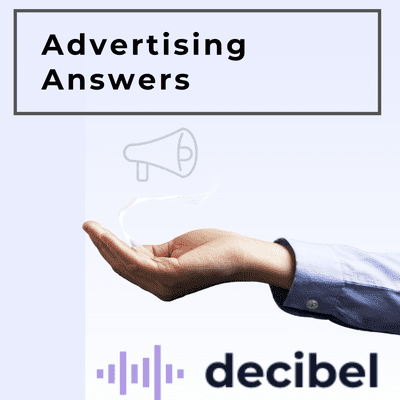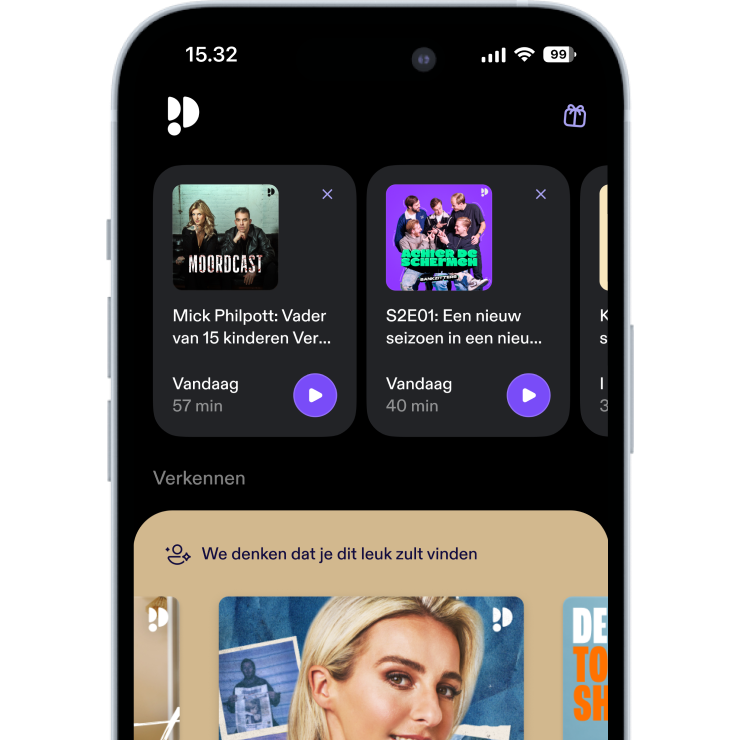
Advertising Answers
Podcast door Jeromy Sonne
Tijdelijke aanbieding
3 maanden voor € 1
Daarna € 9,99 / maandElk moment opzegbaar.

Meer dan 1 miljoen luisteraars
Je zult van Podimo houden en je bent niet de enige
Rated 4.7 in the App Store
Over Advertising Answers
Advertising for small businesses has bever been easy, but it seems like it's getting more challenging all the time - Advertising Answers by Decibel Ads is going to change that. Each week you'll get to hear from industry leading experts as they share their best tips and insights for staying competitive and current in a constantly changing market. You'll also hear the CEO of Decibel Ads, Jeromy Sonne answer questions from entrepeneurs like you - always with a focus on keeping things actionable and applicable to where you are in your business right now. Tune in each week for your dose of Advertising Answers. It doesn't have to be so hard.
Alle afleveringen
8 afleveringenKanika Misra is a CRO expert and Strategy Officer and Managing Director at BedaBeda Growth. She is also Managing Director at Desi-Derata, an advisor for various startups, and the Head Lacrosse Coach at Somerville Public Schools. She joins Jeromy Sonne to discuss conversion optimization, the difference between UI and UX, and testing strategies. CRO Misconceptions [2:05] One of the biggest misconceptions around optimizing conversions is that it entails “just throwing a bunch of spaghetti at a wall and seeing what sticks,” according to Kanika. While a lot of testing is involved, it is very insightful and data-driven. Kanika’s Foray Into Testing Strategy [6:45] “I unknowingly created a testing strategy to complete a task,” Kanika shares. “I didn't really like testing [and] I didn't really know what I was doing. I said ‘hey, we're pushing out this volume of content without any rhyme or reason; whenever we get people to come through that content we don't know what we should post… we [organized] it by buckets… over the course of about the next six months were able to get 200,000 people to the site every single month for free,” she continues. UI vs. UX [15:08] There’s a huge distinction between UI and UX, as they’re totally different disciplines. “Even though they use the same tools, it would almost be like looking at a plumber and looking at an electrician and saying ‘well, you both build houses and use your hands,’” Kanika explains. “It's a really difficult thing for people to get their minds around because they're both so valuable in completely different ways.” Beauty over Value [25:57] One mistake that people make often is focusing on looks rather than value. ‘Ugly’ pages generally perform better than pretty pages because the owners spend so much time on the copy, they focus on the direct response. They focus on making sure that what they're saying matches up with everything else that they have in front of them. Whereas pretty pages generally focus on ‘hey, let's just make this really pretty and not worry about what words we’re saying.’ Resources Kanika Misra on LinkedIn [https://www.linkedin.com/in/kanikamisra/]| Twitter [https://twitter.com/kanika_misra]
Shane Cicero is the owner of JW Media, where he helps local businesses optimize their Facebook ads to bring in better leads and more sales, so they can focus on what they do best. He also works with Foxwell Digital, an agency of paid social media advisors focused on transparency, honesty, and authenticity. Shane joins Jeromy Sonne to discuss what people should know as they plan for Q4. A World of Changes 1:40 Apple has brought about changes to privacy policies that have created some big shifts on most digital advertising platforms, especially social ones, Jeromy says. Those currently running advertisements for their businesses may already be seeing those shifts in action. Q4 Planning 5:29 Q4 refers to a specific time at the end of the year, when customers are in a buying mood and also when the most money is spent on advertising. It is the most expensive period of the year on Facebook and Instagram for advertisers, but it can also be the most profitable. People typically plan for Q4 in July through August, but Shane prefers to begin the year with Q4 in mind to spend that time building up a customer base and audience so he can better target them in Q4. Getting the Timing Right 14:36 People looking to hop into advertising on Facebook and Instagram for the first time as a brand new company to test the waters for their product should avoid doing so in October or November, Shane advises. Starting from scratch in Q4 is challenging, and unless you have that instant impulse-buy kind of product, which very few have, you will face difficulties in getting engagement and sales. What Not to Do During Q4 22:06 One thing you should absolutely avoid doing, especially if you are a medium-sized business, is throwing your eggs in too many baskets. “I don’t think you should go and say ‘okay, it’s Q4; I'm gonna do google ads, I'm gonna do audio, I'm gonna do Facebook and Instagram, [etc.],’” Shane shares. “What I would say is absolutely hop on Facebook and Instagram; it's likely going to be your most powerful traffic driver and get you the best results.” Resources Shane Cicero on LinkedIn [https://www.linkedin.com/in/scicero24/] | Twitter [https://twitter.com/jimmyWHAT24]
Rok Hladnik is a Facebook Marketing expert and former newspaper CEO who started media buying as a hobby five years ago. Today, Rok has extensive knowledge and experience in digital marketing, advertising, and media. In this episode, he joins Jeromy Sonne to discuss the world of Facebook ad optimization and teaches listeners how to understand the statistical side of advertising. Misconceptions about advertising and what it really is [2:07] Advertising in the real world is more than just sitting around and brainstorming cool pitches, despite how it is portrayed in Mad Men. At its core, the success of advertising depends on statistics and being able to gauge what is behind the numbers. Understanding advertising numbers as a beginner [4:10] A few years ago, it was difficult to make predictions on advertising numbers because databases and relevant information were unavailable. In the last year however, Rok says, companies have improved a lot with their advertising blueprints. He suggests that beginners study these blueprints to understand what the numbers mean. Business owners can also join Facebook groups to be exposed to other advertisements but, he cautions, be wary of the credibility of information shared there. How to set new clients up for success [6:57] Rok’s first step in guiding new clients is conducting an audit process of their accounts to evaluate how much assistance they need. Next, he checks the copy and creatives to see the target audience and possible marketing angles. This can include creating new accounts if necessary. Lastly, he emphasises the importance of Facebook’s algorithm and how it works. Facebook’s algorithm shows ads to the people it believes the product would be most relevant to. As such, your test audiences should be as broad as possible yet as niche as possible. Rok recommends ‘sandbox’ campaigns where different audiences, copy, and creatives are tested to see what the winning ad will be. Campaign Budget Optimization (CBO) can also be utilized. Advice to make sense of the ad information and take steps forward [11:58] If a small business already has ads posted, they should use those posts as tests to see which ones attracted the best engagement and try to take further ads in a similar direction. Rok surmises that “the creative part is harder than the audience part.” He explains the elements of a good ad. The ‘funnel’ concept [15:19] The top funnel consists of customers seeing the ad for the first time, Rok tells Jeremy. At this stage, video creatives are best as it tells the viewer what the brand is about. The middle funnel is made up of people who may have engaged with the ad but are not visitors yet. Pictures are best here. The bottom funnel contains customers who came to the webpage but just did not finish the purchase. Engagement is not needed, only the push to purchase. Rok warns against niching audiences and structuring too much when making projections. ‘What works best is a combination of interests altogether.’ Facebook’s algorithm helps find the right customers if you give it sufficient broadness to do so. Correct avenues to take in advertising [19:33] You should test everything beforehand and periodically to see what works best, so a testing budget is imperative. Rok advises companies to figure out their best-selling headline and description because those two things are what people look at after the creative catches their attention. RESOURCES Rok Hladnik on Twitter [https://twitter.com/rokhladnik?ref_src=twsrc%5Egoogle%7Ctwcamp%5Eserp%7Ctwgr%5Eauthor] | LinkedIn [https://si.linkedin.com/in/rok-hladnik-01765820]
Jeremiah Prummer is CEO and co-founder of KnoCommerce, a software organization that helps e-commerce brands leverage data to find customers and create meaningful interactions. Jeremiah has a demonstrated history of excellence in e-commerce and conversion rate optimization. He joins Jeromy Sonne to discuss attribution analytics and how they can be used to improve performance. Managing Your Advertising Spend 2:31 There is a famous saying that goes ‘Half of my advertising spend is wasted; I just wish I knew which half.’ Today the internet has given businesses access to greater tools, which bring us closer to answering that question. If you're running a leads-focused e-commerce business, you need to understand where your customers are coming from and what impact your advertising spend is having, so you can become more efficient, he adds. Personal Privacy Policies and Protection 6:04 Trying to balance respecting the privacy of the individual with giving companies the information they need to advertise has been a slippery slope for organizations. Evidently, they had not been doing a good job of it, so the government stepped in to enforce new privacy laws. Companies like Apple decided to stay ahead of the curve and buckle down on these policies, according to Jeremiah, because privacy is only going to accelerate in the future. Attribution Analytics 14:21 When launching a product, asking the question “How did you hear about us?” provides you with the customer’s most memorable point of contact. Jeremiah recommends asking two more questions to glean more information about attribution: “Where else have you heard about us?” and “How long did you know about us before you made your first purchase?” What eCommerce Owners Should Know 23:57 Every e-commerce store should understand their platform-level metrics, Jeremiah advises. Ensure that you have some kind of click-tracking system to collect data. Shopify, Inquire Labs, and Grapevine are good platforms with tools that can help you get started on using attribution and survey data to improve advertising and performance. Resources Jeremiah Prummer on LinkedIn [https://www.linkedin.com/in/jeremiahprummer/]
Josh Johnston is a professional marketing consultant who helps digital marketing agencies with operational structure, fleshing out systems, and building team continuity. He is the former COO at Dwelling Media. He joins Jeromy Sonne to discuss the importance of systems and hiring the right people, and building operations. Systems and Scaling 1:37 Agencies and small to medium sized businesses depend on systems for their marketing, Jeromy remarks. Many organizations attribute their marketing success to a singular talented individual or a group of them. Eventually, however, they will get burnt out, as it is impossible to bring 300% of effort, energy, and creativity every day for years; especially if they are trying to scale up. Josh describes how people can begin to build their operations for scale. The Three Levels of a Business 7:19 Josh defines a swimlane as a broad way of thinking about a discipline. There are three levels to it in a business: level one is when you are a solopreneur, and you make all the decisions for your business and do the labor; level two is when you don’t do the labor and instead delegate, but you still make the executive decisions; and level three is when you delegate both decisions and labor. Hire Quick, Fire Quicker 15:22 Finding the right people for the job is important to a business’ operations. It’s often a difficult task, and interviews may not be enough to determine if a person would be suitable. Talents, skills, experience, and whether they would be a good culture fit should all be considered when hiring someone. Additionally, new employees should go through a probationary period when they are first hired to ensure that, in the event they aren’t suitable, they can be removed quickly. Putting the Pieces Together 23:10 Jeromy asks Josh how the complexities of operations can be broken down into simplicity. “If you’re going to be CEO of an agency and you want to be successful, you’re going to have to go a million miles per hour,” Josh says, “which means you’ll often neglect the smaller pieces that keep everything together.” He advises listeners to hire an operations manager instead of a COO initially, as they are significantly less expensive and can essentially perform the same function. Walking the Talk, Talking the Walk 30:34 A common misconception about core values is that they are cliches that you hang up on your wall. When your team is aligned with and actively lives out those values, Josh argues, it transforms your business. They become easy to recall because they are integrated in every operation. Josh shares his company’s core values and gives a brief description of what each one entails. Resources Joshua Johnston | LinkedIn [https://www.linkedin.com/in/joshua-johnston-a68ab35a/] | Instagram [https://www.instagram.com/joshykobyashi/?hl=en] 321 Pocket Ops [https://321pocketops.com]

Rated 4.7 in the App Store
Tijdelijke aanbieding
3 maanden voor € 1
Daarna € 9,99 / maandElk moment opzegbaar.
Exclusieve podcasts
Advertentievrij
Gratis podcasts
Luisterboeken
20 uur / maand

































